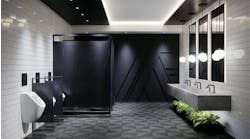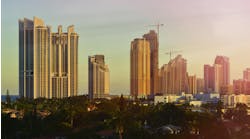Ever wish you could get paid for turning off your lights or cutting back on AC? Participate in a demand response (DR) program and you’ll put dollars back in your pocket. Take energy efficiency to a whole new level when you can cut your electrical load in a matter of minutes.
Who Can Participate in Demand Response?
Demand response is a unique energy contract with a utility or curtailment service provider (CSP). This financial arrangement calls for load shedding when the grid is in distress or in response to price fluctuations. Facility managers receive notification of an event and take measures to reduce their energy consumption accordingly.
Demand response programs aren’t available on a national scale yet. Only a handful of states offer participating programs, including California, Texas, and most of New England. However, your local utility may offer a program, so investigate opportunities in your region.
Regardless of your location, energy prices and consumption are key factors in whether a program will be a successful match for your facility.
“Places where the electricity used on a typical day is much less than on a peak day are some of the areas where demand response is the most valuable,” says Tony Abate, R & D project manager for NYSERDA, the New York State Energy Research and Development Authority. “In New York, for example, almost double the amount of power is used on a typical day compared to a day during a summertime heat wave.”
Your building’s potential for demand response also depends on these factors:
- Total energy spend
- Square footage
- Mechanical and HVAC systems
- Range of building controls
“As a rule, anything under 25,000 square feet is too small for a successful demand response program,” says Matthew Plante, vice president of energy efficiency at EnerNOC, a a national CSP. “There aren’t large electrical loads for those buildings, so it’s harder to install equipment and get a return on the investment.”
Demand response may not be as effective in older buildings with few or outdated central controls, he adds. However, load shedding can be ideal for retail and big box stores because of the constant energy use.
No matter what type of facility you have, you need loads that can be shifted easily without affecting clients or business operations. Reducing energy consumption won’t have any benefits if it negatively impacts productivity, health, or safety, cautions Abate.
What Are the Benefits?
The advantages of demand response are far-reaching with few downsides. Consider these positive impacts:
- Owners earn a direct payment from the service provider for their usage flexibility. This additional income can be rerouted to other building and sustainability projects.
- Demand response often leads to energy efficiency, which results in a better functioning building. Many utilities incentivize building owners to make energy upgrades when starting a DR program.
- Power outages cause immediate disruptions to businesses and schools, so many facility managers need little motivation to ensure grid reliability for their neighbors and themselves. “You’re helping to keep the lights or the heat on,” Plante explains. “When people have the ability to do a social good, that’s often a driver of behavior.”
- Demand response has little bearing on occupants. Energy use is reduced behind the scenes so front-of-house operations carry on with little to no disruption.
- DR programs should be painless to busy facility managers, says Plante. Automation or remote control reduces the time and attention required for manual adjustments.
Beyond individual buildings, demand response also benefits the existing energy structure. Greater grid stability can halt the construction of new power plants and help offset fluctuations in power supply from renewable energy sources.
Which Program Makes Sense?
While some utilities may offer only one choice, there can be many variations within DR programs. “The requirements of the program are dictated by the needs of the utility and the grid operators,” explains Abate.
“The length of dispatch differs between territories,” adds Plante. “It may be as short as 10 minutes or as long as six hours. The amount of advance notification also varies.”
While programs can be highly individualized, most fall into three types. Reliability is one of the most popular and least intrusive programs.
Under this arrangement, you respond to grid distress (emergencies) typically once or twice a year to ensure distribution systems stay on. This requires integral metering in place and the ability to manually shut off mechanical systems.
“Within these, you choose between a voluntary and a mandatory program,” says Abate. “Voluntary lets you curtail without penalty and mandatory is a contract where you curtail with a penalty for non-performance.”
Pricing programs respond to spikes in market prices. Given the volatility of utility prices, this allows participants to cut back energy when prices are at their highest. Buildings owners often receive hourly prices a day in advance.
You can also participate in demand bidding. When notified of an event, your facility dials in with an estimate of how much load you can shed for the specified time. The utility or CSP will then respond with how much it’s willing to pay if you can meet your estimate.
“If you’re responding to a price or bidding, you’ll want to have automated control of your loads,” recommends Abate. “It’s very difficult to curtail on a real-time basis manually. “
Because utilities are starting to pay more for a quicker response, it may be advantageous to have a building automation system regardless of which program you select. “You can program a demand response mode so the set points and loads can be adjusted and delayed automatically,” Abate explains.
What Should a Provider Offer?
Whether you are working with your local utility or an independent CSP, a service provider should be a trusted partner for your organization.
“A CSP should be willing to understand what the building operator expects from the building and what the operating parameters are,” Abate recommends. “They should provide an honest assessment of what kind of curtailment the building is capable of and be able to assist with automating the program if that’s the best strategy.”
Demand Response Bolsters Hotel’s Green Goals
DR programs like the one implemented by the Seaport Hotel help operators to maintain stability of the power grid during periods of peak demand.
The Seaport Hotel, a 333,000- square-foot facility in Boston, is in its third year of participating in a demand response (DR) program. With the help of curtailment service provider EnerNOC, the hotel receives over $7,500 in DR payments annually for shedding energy loads on short notice.
When EnerNOC announces a DR event, appropriate hotel managers receive emails and phone calls informing them of the event. Controlled centrally via the hotel’s building management system (BMS), the facility can make load changes within five minutes of notification.
“We’ve created a program in the BMS that allows for all affected systems to be grouped together,” says Matthew Moore, director of rooms and sustainability. “It gives us a simple way to reduce our energy use by the appropriate amount quickly and easily. It also makes it easy to return systems to normal operation.”
To temporarily achieve the targeted reduction of 300 kW, the hotel adjusts its air conditioning, reduces laundry activities, and shuts off or dims non-essential lighting in common and garage areas.
In addition to the payments and positive environmental impact, one of the greatest advantages of demand response to the Seaport Hotel is the nearly invisible impact to guests. “Patrons continue to enjoy our facility during events without any interruption whatsoever,” says Moore.
Both parties need to sit down and carefully review how the DR program works. Remember that this is an energy contract and you want to fully understand what you’re committing to.
Be prepared to cover the different demand response options, what your responsibilities entail, how payments are calculated and distributed, and how penalties may be incurred.
It can also be beneficial to seek out a CSP separate from a utility if you have a building portfolio across multiple regions, advises Plante. This allows you to view all of your buildings’ energy use on one platform.
Keep the Ball Rolling
Beyond installing meters and energy dashboards as necessary, little else is needed to start up a DR program. Abate recommends doing an acceptance test prior to launching the program in full. Use a mock event exercise to iron out any wrinkles and monitor how effective your load shedding is.
Be clear with tenants about how demand response could impact them. Whether it’s shutting down an elevator bank or reducing lighting in the lobby, tenants should be notified of any changes. People appreciate knowing that the efforts taken have productive benefits for their community, but some may also be wary of cutting energy if they pay a flat utility fee.
You can also advertise your demand response participation in all of your marketing efforts, particularly for attracting new tenants. Use leasing agreements to give new or existing occupants an idea of how demand response will play out in their space.
“Building owners can incorporate items into their lease so tenants can agree beforehand how the building will be operated during those peak times,” says Abate. “This usually gives permission to the facility manager to raise the temperature in a certain way for a period of time.”
As you move forward with demand response, be vigilant about looking for new energy projects to pursue. Low-hanging fruit is good to address prior to implementing a DR program, but permanent energy reduction reduces your need to shed loads in the first place.
“We emphasize that energy is a controllable cost,” posits Plante. “Customers typically view themselves as passive consumers of electricity – their energy spend is a direct function of their product, square footage, or occupancy. That’s not true. They can affect their energy spend and demand response is just one way of doing that.”
Jennie Morton ([email protected]) is associate editor of BUILDINGS.


